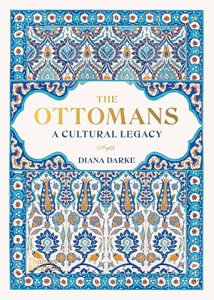The Ottomans: A Cultural Legacy

Author: Diana Darke
Publisher: Thames & Hudson
Year of Publication: 2022
Print Length: 288 pages
Genre: Non-Fiction / History, Art, Cultural Studies, Social Science; Islamic Studies / Hadith, Sunnah & Sirah; History, Science
Area: Ottoman Empire, Europe, North Africa, the Middle East, Turkey/Turkiye
Topic: The Ottomans, Muslim, Jews, Christian, The Muslim World, Islam, Cultural Heritage/Legacy, Culture & Society, History, Human Nature & Character, Human Psyche, System, Architecture, Archive, Art & Design, City & Urban, Cuisine, Innovation, Science, Language & Literature, Music, Medicine & Healthcare, Trade, Scholarship & Knowledge, Housing, Lifestyle, Leadership, Governance, Organization, Politics & Power, State Formation, Identity, Migrants, Migration, Minority Rights, Mobility & Immobility, Refugees & Forced Migration, Resilience, Tolerance, Movement of People and Ideas, Freedom to Move and to Stay, Civilization
A richly illustrated examination of the Ottoman Empire, 100 years since its dissolution, unraveling its complex cultural legacy and profound impact on Europe, North Africa, and the Middle East.
A hundred years after the abolition of the Ottoman sultanate on November 1, 1922, enough time has passed to reexamine the Ottomans and reassess their legacy. This illustrated volume, by critically acclaimed author Diana Darke, explores their unique achievements in architecture, cuisine, music, science, and medicine, as well as the political challenges they met. The Ottoman Empire faced issues shared by modern European and Middle Eastern countries: how to maintain a balance between religious ideology and secular politics and how to promote fairness and equality among citizens in a multicultural society.
While many still equate the Ottomans with the decadence of Istanbul—extravagant architecture, harems, and hookahs—they are unaware that the secrets of Ottoman success lay in a disciplined bureaucracy and a standing army that both awed and seduced its opponents. The Ottomans harnessed the talents of their diverse populations and quickly buttressed the crumbling edifice of Byzantine Christianity. Their dynamism and resilience helped fuse the cultures of Asia, Europe, and Africa, from the Himalayas to the Sahara, absorbing whatever impressed them, from Mongol armor to Persian tile work. Alongside their essential rigor, they enjoyed the finer aspects of life: in music, cuisine, and art, unafraid, even as rugged fighters, to display their love of flowers and gardens, especially tulips and roses. Behind the fine robes, carpets, and ceramics on display today in their great architectural monuments, Istanbul’s Topkapi Palace and Hagia Sophia, lie centuries of migration, trade, and struggle. In this original and beautifully illustrated book, Darke reveals a radically new picture of the Ottoman Empire.
Table of Contents
Introduction: A Fresh View
1. The Ottoman Psyche
2. The Commercial Spirit
3. Statecraft and Geography
4. Religious Values
5. Scientific and Industrial Innovations
6. Literary Curiosities
7. Musical Traditions
8. Medical Mores
9. Aesthetic Sensitivities
10. Architectural Identity
11. Culinary Delights
12. Home and Lifestyle
Conclusion: Lessons for the Future?
Select Bibliography
Notes
Sources of Illustrations
Index

Diana Darke is an independent Middle East cultural expert and Syria specialist, frequently invited to speak at international events and media such as the BBC, PBS, TRT, Al-Jazeera and France24. She studied Arabic at Oxford University, before beginning her professional career with the UK’s GCHQ as an Arabic linguist. She went on to spend over twenty years working in the intelligence and counter-terrorism world, with both the British government and British industry, whilst living in a range of Arab countries, including Lebanon, Syria, Egypt, Oman and Dubai. Along the way she authored 15 detailed guides to the region, including five on Turkey, most recently Bradt’s Oman, Eastern Turkey, North Cyprus and Syria. In 2005 she bought a semi-derelict courtyard house in the Old City of Damascus, restoring it with the help of local craftsmen, a process which enabled her to become deeply embedded in Syrian society, and also led her back into the academic world to study Islamic Art and Architecture.
Source: https://www.mei.edu/profile/diana-darke
More from Diana Darke in this library, click here.
